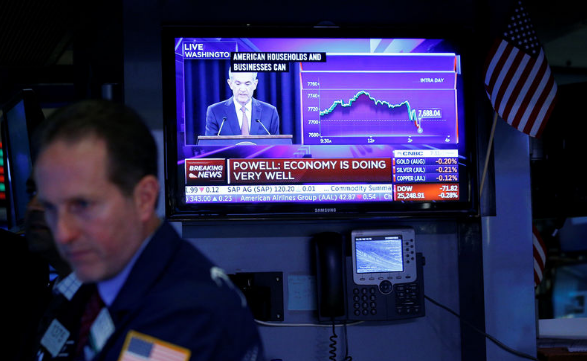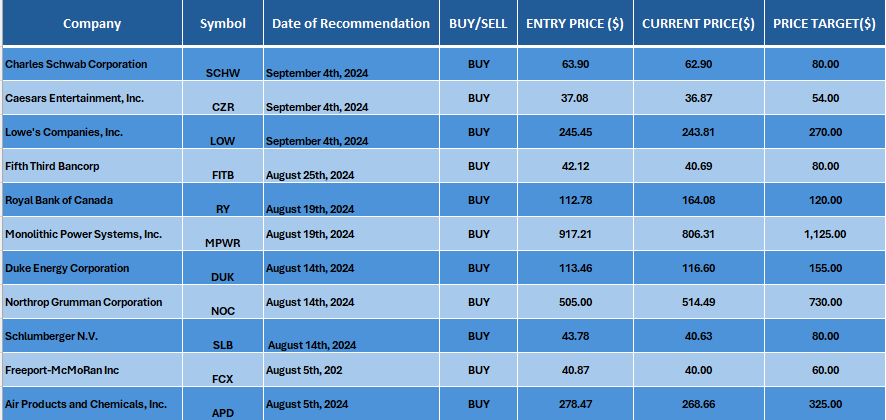
Date Issued – 18th September 2024
Market Focus Shifts to Landmark Fed Decision, Futures Edge Higher
1. Focus on the Fed
The Federal Reserve is at the center of market attention as investors eagerly await its crucial interest rate decision. As speculation mounts, the debate centers around whether the Fed will opt for a 25-basis point cut or a more aggressive 50-basis point reduction. This would mark the first rate cut since March 2020, a significant shift as the Fed seeks to balance economic momentum and inflationary pressures. The FedWatch Tool by CME Group currently reflects a 61% probability of a larger 50-basis point cut, fueled by reports from the Financial Times and Wall Street Journal, which indicate the possibility of a jumbo cut. Former New York Fed President Bill Dudley adds weight to the argument, stating a “strong case” exists for the larger cut, as current rates may be above neutral territory. However, mixed economic data, including stronger-than-expected retail sales in August and tepid inflation trends, makes this a closely contested decision. Analysts at ING describe it as a “close call,” underscoring the uncertainty in the macro outlook. Investors are also eyeing potential signals from the Fed on future rate cuts, with markets anticipating at least 100 basis points in reductions by the end of 2024.
2. Futures Edge Higher
Ahead of the Fed’s pivotal meeting, U.S. stock futures inched upward. As of 03:30 ET (07:30 GMT), Dow futures added 45 points (0.1%), S&P 500 futures edged higher by 7 points (0.1%), and Nasdaq 100 futures gained 39 points (0.2%). These modest gains follow a turbulent Tuesday session, where positive retail sales data propelled the S&P 500 and Dow Jones Industrial Average to record highs, only for markets to fade on Fed uncertainty. The tech-heavy Nasdaq Composite closed the day with a slight 0.2% increase.
3. 23andMe Directors Resign Over Take-Private Offer
Genetic testing firm 23andMe faced board upheaval as all seven independent directors resigned following failed negotiations with CEO Anne Wojcicki regarding her proposal to take the company private. The board expressed disappointment over the lack of a “fully financed, actionable proposal” that would benefit non-affiliated shareholders. Wojcicki controls 49% of the company and had offered to buy remaining shares at $0.40 each, a move rejected by a special committee. In a memo to employees, Wojcicki stated she was “surprised and disappointed” by the resignations, reiterating her belief that going private would free 23andMe from the short-term pressures of public markets. Shares plummeted in extended trading following the announcement.
4. Nippon Steel Wins Extension on U.S. Steel Deal Review
Nippon Steel’s $14.1 billion bid for U.S. Steel is receiving a prolonged security review, potentially extending the timeline past the U.S. presidential election in November. Bloomberg reports that Nippon Steel was granted the ability to revoke and refile its submission to a U.S. security committee, a strategic move amid political sensitivities surrounding the deal. President Joe Biden has publicly opposed the transaction, further complicating the outlook, particularly as U.S. Steel is a major player in Pennsylvania, a key battleground state in the 2024 election. Shares of U.S. Steel rose 3% in aftermarket trading on the news.
5. Oil Prices Decline as Inventories Rise
Oil prices dipped in early European trading, trimming recent gains following an unexpected increase in U.S. crude inventories. Brent futures fell by 0.5% to $73.33 per barrel, while West Texas Intermediate (WTI) dropped to $69.63. Despite the short-term pullback, prices remain elevated on the back of supply disruptions from Hurricane Francine and anticipation of Fed rate cuts, which have pushed traders to take advantage of discounted oil prices. Additionally, rising Middle East tensions are contributing to price volatility, with Hezbollah threatening retaliation against Israel. Both Brent and WTI contracts have rebounded sharply over the past week, recovering from three-year lows.
Why Big Banks Are Obsessed with 1995
The echoes of 1995 are growing louder on Wall Street, and for good reason. That year, a series of Federal Reserve interest rate cuts sparked one of the best multiyear periods in banking history. With inflation cooling and U.S. consumer spending slowing, the Fed reduced rates by 25 basis points in July, December, and again in January 1996. The result? An extraordinary rally for banks. An index tracking the banking sector surged by more than 40%, outperforming the broader market for two consecutive years. Today, with speculation rising over potential Fed rate cuts in 2025, many financial institutions are drawing parallels to that remarkable period, hoping for a repeat performance. While the path to another 1995-like boom may seem distant, Wall Street analysts and bank executives are contemplating what it would take to recreate such a winning streak.
A Strong Start for 2023
The banking sector has already posted respectable gains this year. The KBW Nasdaq Bank Index (^BKX), which tracks large U.S. banks, is up over 14%, and the Financial Select Sector SPDR Fund (XLF), which includes a wide range of financial institutions, has gained 19%. However, these gains still lag behind major market indices. As Mike Mayo, an analyst at Wells Fargo, puts it: “History isn’t likely to repeat, but it may rhyme.” While Mayo is cautious about expecting a full repeat of 1995, he notes that key similarities are emerging. In particular, Mayo points out that in three instances—1995, 1998, and 2019—where the Fed cut rates without triggering a recession, bank stocks initially sold off before rebounding and outperforming the S&P 500. However, history also shows that only in 1995 did this outperformance last longer than three months after the initial rate cut.
1995: A Turning Point for Banks
The conditions leading up to the 1995 boom were far from ideal for banks. Major institutions were reeling from the bankruptcy of Orange County in December 1994 and the collapse of British merchant bank Barings in early 1995. The bond market had suffered a significant wipeout, leading to substantial trading losses. Meanwhile, commercial real estate lenders were still grappling with loan losses from a crisis dating back to the late ’80s.
Despite this, a key factor worked in favor of the banking sector: a steep yield curve. Long-term Treasury yields remained higher than short-term rates, allowing banks to profit from the spread between borrowing at short-term rates and lending at long-term ones. Moreover, deregulation provided a tailwind, with new laws allowing banks to open branches across state lines, setting the stage for the emergence of mega-banks like Wells Fargo and Bank of America.
Could Regulation Swing Back to Favor Banks?
Today’s regulatory environment is different from 1995, but some believe the pendulum may be swinging back in favor of big banks. While regulation has tightened since the Trump administration, recent developments suggest a potential easing. For instance, new bank capital rules introduced last week were less stringent than initially expected. Additionally, the Supreme Court’s rejection of the Chevron doctrine, which granted regulatory agencies broad authority in interpreting laws, may limit regulatory power moving forward.
However, there are significant differences between now and 1995. The current shift in monetary policy follows one of the longest periods of low interest rates in U.S. history. During the pandemic, banks experienced a surge in deposits, which left many institutions ill-prepared for the recent sharp rate hikes. As Allen Puwalski, CIO at Cybiont Capital, noted, “There’s no argument that falling rates are good for banks. I’m just not sure it’s for the same reasons that it was in ’95.”
The Path to 2025: Can Banks Repeat 1995’s Success?
For 2025 to be as strong for banks as 1995, the Fed would need to engineer a “soft landing”—reducing inflation without triggering a recession. This is a challenging task, but not impossible. As former Boston Fed President Eric Rosengren told Yahoo Finance, “There are plenty of things that could go wrong, but I think it’s a high enough probability that it’s still reasonable to talk about a soft landing.” Looking ahead, banks that have benefited from high interest rates may see shrinking profits, while those that struggled could be poised for a rebound. At a recent Barclays conference, several bank executives, including Bank of America CEO Brian Moynihan and PNC CEO Bill Demchak, expressed optimism about earnings in 2025. Others, like JPMorgan Chase COO Daniel Pinto, were more cautious, warning that analysts might be too optimistic about future earnings.
Conclusion: A Dream Worth Pursuing?
While a repeat of 1995 may seem like a long shot, the banking sector is once again in the midst of significant change. Loan growth, a revival in investment banking, and a favorable regulatory environment could provide the necessary ingredients for another rally. But as RBC Capital Markets analyst Gerard Cassidy cautions, “We do expect to see incrementally higher loan loss provisions in the next 12 months.” In the end, while betting on a repeat of 1995 may be risky, the industry’s trajectory is pointing in the right direction—making it a dream worth keeping an eye on.

BlackRock and Microsoft Aim to Raise $30 Billion for AI Investments
BlackRock Inc. and Microsoft Corp. have joined forces in a major initiative to fund the expansion of data centers and energy infrastructure essential to supporting the explosive growth of artificial intelligence (AI). Alongside the United Arab Emirates’ MGX investment vehicle, the two firms are targeting $30 billion in private equity capital for the project, with the potential to leverage this sum into as much as $100 billion in investments over time. According to BlackRock CEO Larry Fink, the Global AI Infrastructure Investment Partnership has been in development for months. The aim is to fund the global buildout of data centers, a project estimated to require trillions of dollars in financing. “This is a prime example of capital markets driving infrastructure development and enabling new technologies,” Fink said.
The infrastructure projects, which will focus on both data and energy investments, are expected to be concentrated in the U.S., with some funds allocated to partner countries. The companies are seeking additional investors for the effort, and Fink expressed confidence that raising the capital would not be a challenge, citing strong interest from pension funds and insurers eager for long-term infrastructure investments. Key players in this initiative include Global Infrastructure Partners, led by Bayo Ogunlesi, which BlackRock is acquiring for $12.5 billion, and Abu Dhabi’s MGX, a newly established investment entity focused on AI. Nvidia Corp., a leading chipmaker, is also part of the collaboration, providing its expertise in building AI data centers and systems, as well as critical software and networking technologies.
Microsoft Vice Chairman Brad Smith emphasized the immense investment opportunity AI presents, describing it as “the next general-purpose technology” poised to drive growth across industries globally. Microsoft, which has already invested $13 billion in OpenAI, is heavily investing in AI-focused data centers and infrastructure to support the burgeoning demand. The company is also grappling with the challenge of limited data center capacity and chip shortages, which constrain its ability to serve AI customers.
Energy and Infrastructure Challenges
One of the most significant hurdles facing the AI boom is the immense energy demand from data centers. According to Bloomberg Intelligence, electricity usage by these facilities is expected to surge up to tenfold by 2030. This has prompted energy companies across the U.S. to delay the retirement of coal and gas plants, plan new gas plants, and ramp up investment in renewable energy sources such as solar and wind farms. However, competition for electricity has already extended the time needed to connect new data centers to the grid up to seven years in Virginia’s Data Center Alley.
Ogunlesi underscored the critical need for increased power generation, stating, “Power availability is now a key constraint on not just data center expansion but broader electrification efforts. We must accelerate the development of renewable energy plants in the U.S.” In parallel, Microsoft has been in discussions with OpenAI co-founder and CEO Sam Altman, who is working on his own plans to bring together investors and tech firms to massively expand the infrastructure needed for AI products. As AI continues to evolve as a transformative technology, the collaboration between BlackRock, Microsoft, and their partners highlights the scale of investment and infrastructure required to meet the industry’s rapid growth.
JPMorgan CEO Jamie Dimon to Visit Africa in Strategic Expansion Push
Jamie Dimon, CEO of JPMorgan Chase, is set to visit Africa in mid-October as part of the bank’s strategy to expand its presence on the continent. This will be Dimon’s first trip to Africa in seven years, with planned visits to key markets including Kenya, Nigeria, South Africa, and Ivory Coast, according to sources familiar with the matter. JPMorgan already operates in South Africa and Nigeria, offering asset and wealth management, as well as commercial and investment banking services. The bank, which holds over $4.1 trillion in assets and operates in more than 100 countries, is actively targeting international markets as a growth strategy.
In 2018, Dimon had expressed interest in expanding into Ghana and Kenya, although local regulatory hurdles initially slowed these efforts. However, recent developments suggest renewed momentum: Kenyan President William Ruto announced in early 2023 that JPMorgan had committed to opening an office in Nairobi. The timeline for entering Ghana and Kenya remains unclear. The move is part of a broader trend where major global banks are increasingly eyeing Africa’s sovereign debt and corporate transactions. Analysts note that international lenders, like JPMorgan, are also looking to provide wealth management services for multinational companies with African operations. Eric Musau, head of research at Standard Investment Bank in Nairobi, explained that such offerings typically focus on access to offshore equity, debt, and mutual funds, which international banks view as key growth areas.
In addition to wealth management, private banking services are gaining traction in Africa, particularly as global banks seek to differentiate themselves from local and regional competitors. Francis Mwangi, CEO of Kestrel Capital in Nairobi, sees private banking as “the next evolution” for financial services on the continent, where most consumers currently rely on local commercial banks. JPMorgan has emphasized its commitment to international expansion, prioritizing growth in overseas markets. As of May 2023, the bank ranked among the top five international private banks by assets under supervision. In recent years, JPMorgan has significantly bolstered its global footprint, adding 700 bankers across 27 new locations, generating $2 billion in additional revenue.
Dimon’s Africa visit underscores JPMorgan’s ambition to capture a larger share of the continent’s banking landscape. The bank is supported by an advisory board that includes influential figures with African ties, such as Nigerian billionaire Aliko Dangote and former UK Prime Minister Tony Blair.
As competition intensifies, global banks are adopting diverse strategies in sub-Saharan Africa, targeting the most promising markets. Standard Chartered, for example, has focused its efforts on Kenya, where assets under management surged by 25% to $1.4 billion in 2022. Meanwhile, the bank has scaled back in other parts of the region, exiting markets such as Angola, Cameroon, and Sierra Leone. JPMorgan’s expansion push signals its belief in Africa’s growing importance in global financial markets, with the continent’s rapid development offering fertile ground for investment banking and wealth management growth.
Factbox: Airlines Suspend Flights as Middle East Tensions Rise
International airlines are adjusting their flight operations amid escalating tensions in the Middle East, with several carriers suspending services to affected regions or avoiding particular airspaces. Here’s a summary of the changes made by some airlines:
Airlines Suspending or Adjusting Flights:
- Air Algérie: Suspended flights to and from Lebanon until further notice.
- AirBaltic: Plans to resume flights between Riga and Tel Aviv on Sept. 17.
- Air France-KLM:
- KLM canceled all flights to and from Tel Aviv until Oct. 26.
- Transavia (a low-cost subsidiary) canceled flights to Tel Aviv until March 31, 2025, and to Amman and Beirut until Nov. 3.
- Air India: Suspended scheduled flights to Tel Aviv indefinitely.
- Cathay Pacific: Canceled all flights to Tel Aviv until March 27, 2025.
- Delta Air Lines: Paused flights between New York and Tel Aviv until Oct. 31.
- EasyJet: Stopped flights to Tel Aviv in April, with plans to resume on March 30, 2025.
- IAG (Vueling): Canceled flights to Tel Aviv until Jan. 12, 2025, and suspended flights to Amman indefinitely.
- LOT Polish Airlines: Suspended flights to Lebanon but is operating flights to Tel Aviv regularly.
- Lufthansa Group:
- Suspended all flights to and from Tel Aviv and Tehran until at least Sept. 19.
- Swiss International Air Lines suspended flights to Beirut until the end of October.
- Ryanair: Canceled flights to Tel Aviv until Oct. 26 due to operational restrictions.
- Sundair: Canceled flights between Bremen and Beirut until Oct. 23.
- SunExpress: Suspended flights to Beirut until Dec. 17.
- United Airlines: Suspended flights to Tel Aviv indefinitely due to security concerns.
Alerts for Lebanese Airspace:
- The UK government advised airlines to avoid Lebanese airspace from Aug. 8 to Nov. 4, citing potential military risks.
These suspensions reflect heightened concerns over safety and security in the region as airlines take precautionary measures.
Find below some of our Buy/Sell Recommendations. Balfour Capital Group is a distinguished global boutique investment management firm with $400 million AUM and over 1000 Clients.

Disclaimer: This post provides financial insights for informational purposes only. It does not constitute financial advice or recommendations for investment decisions.

